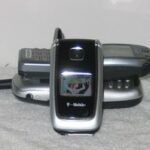Ringtones are making some artists millions today. How many times are you with a friend and their cell phone starts blasting some annoying musical interlude into your conversation? That annoying ringtone could be one of your songs, and you should be hearing the cash register cha-ching every time a cell phone rings. With frequent purchases, cell phone users constantly come back for more ring tones, sometimes on a monthly basis. With advance mobile technologies, cell phone users can also add several individualized ring tones picking different songs for everyone in their phone book.
As a musician, you most likely have a song or two that could speak directly to either the cell phone user or the many contacts in their phone. This rapid growth market is a cash cow for U.S. wireless companies and subsequently for labels and artists too. E-Marketer forecasted that Ringtones will grow from about $1.1 billion in 2007 to $15 billion in the next four years.
With these profit margins in sight, artists and record labels are working directly with wireless companies to reach music fans. The potential of independent artists and labels is no less either, as Industry groups such as the Indie Artist Inner Circle form digital distribution deals for independents. As fast as technology progresses these days, there are new ideas being implemented everyday in the mobile arena, so artists can often be left behind the curve. This is why staying in tune with Industry newsletters and blogs is key.
As much as this often annoying trend is found ringing around every corner more everyday, it’s become an advantageous tool for artists. Just imagine hearing your song being played on someone’s ringtone while you’re waiting on that long line to cash in at the bank. While there is still much fear of piracy in the digital music world, ringtones are one of the few protected methods. So now you’re asking; how do I join the invasion and start annoying people with my songs on Ringtones? There’s a lot to consider when entering this market: picking songs, distribution deals, and even in remixing songs so it’s cell phone savvy. Fortunately, as new as it may all be, there are some successful examples to work from, but also some imaginative possibilities to make the technology your own.
You might get your song out there onto people’s mobile MP3 players, or spread through Podcasts, which is great if a group of people can overhear what’s playing. Getting your songs on a ringtone brings your music out of this more personal realm plugged into users’ headphones and into the open air of a ringing phone. Cell phones are everywhere and people have taken to the idea that their phones have to be as personalized as possible. They want a Ringtone that says ‘look at me, I’m unique”, in their desperate quest for attention and popularity. As an artist, if you can provide songs that most people might not have heard before, but also customize it, you can play into this, reaping the cash rewards.
Ringtones are becoming the new single of the future, and as more Indie artists break into the market, it will surely break a lot of new acts. The key to getting ringtone distribution is in defining your audience (fans) and ask yourself what you would want your ringtone to sound like; put yourself in their shoes. It’s not exactly easy to just up and make a Ringtone and get it distributed. Making the actual ringtone sample from your songs is not all that complicated, and we’ll get to that, but finding the distribution is another story. When Ringtones first hit the market, it seemed like anyone could take a clip from any song and make themselves a sample. Though as labels and artists began to see the potential in this, they got the US Copyright Office involved. So now Ringtones are included in the licensing structure of Digital distribution.
There are a few different kinds of ringtones, Monophonic, Polyphonic and Master Ringtones. As the word implies Monophonic Ringtones use a single tone to play a song and Polyphonic Ringtones, use a variety of tones to play the song. The Monophonic ones are usually one synthesized sound playing the succession of the song’s notes, while the Polyphonic style might add different synthesized tones for harmony, bass lines and drum loops. Master Ringtones use a specific excerpt from the song’s master, or the actual recording of a sample from a song. This way, it’s the real thing.
So, now you go make yourself a ringtone from one of your songs and search for one of the many distributors, sign up and announce it to your mailing list of fans. Sounds easy enough, so why hesitate? You might get screwed is why; ending up licensing your Ringtones to some company that will cheat you out of royalties, or what the Ringtone actually earns. You could also end up with a distributor that only works with one of the Wireless Service Providers, and limit who can download your tones. Avoid this and do your research.
Go to a website like Bliptones.com and check out what an online Storefront for Ringtones looks like. It’s got a selection of Indie artists and they offer Ringtones to phone subscribers with AT&T;, Cingular, Sprint and T-Mobile. This is a good example of a distributor that sells Ringtones on a pay-per-download system. Then go to a Website like www.jamster.com and check out their subscription based service, where users pay a monthly fee and can download a select number of Ringtones for $0.99 per month.
Then check out www.blazetheworld.com, Blaze The World and its partner companies are the largest digital distribution and ringtone providers in the world. They offer Ringtone Distribution for select labels/artists and members of the IAIC. Some other distributors to look into include; JivJiv.com, Betarecords.com, Indie-Mobile.com, Myxertones.com, PocketFuzz.com, XingTone.com and GroupieTunes.com.
Wireless phone companies have also started using something called Ringbacks. The difference is a ringback is a song that plays for a caller waiting for the line to pick up. Cell phone users select a song that plays when someone is trying to call them instead of just hearing the regular ringing tone. They pay extra for Ringbacks and the Wireless Industry expects an additional $2 billion to $3 billion a year in the ringtone market from ringbacks. Ringbacks are also impossible to hack, or pirate, because they are provided directly from the Wireless Company or its affiliate.
There are a few things to keep in mind when creating Ringtones. Some ringtones, honestly sound like garbage, but you can avoid this by considering the technology, specifically the speakers. Too many Ringtones come blasting through with a mass of distorted noise and garbled, inaudible lyrics. Give fans something to cherish, as the whole idea is to broaden your exposure as an artist, so don’t blow it with poor sound.
Some things to keep in mind: Cell phones have mono speakers, so don’t record the sample in Stereo. Make sure the sample is loud enough; it’s supposed to be an alert for a phone call. The sample should have a solid ending at the 10 second or 30 second mark, or a decent fade. Use the philosophy that less in more and don’t use a section of your song that has a lot of noise. Also, try to use samples that don’t have too much low end, like bass, as cell phones don’t bump like car speakers, at least not yet. Be sure to normalize the sample’s volume and keep the file size at or below 100KB. Lastly, while it may be needless to say, always test it out and on a phone if you can. It’s amazing how many ringtones sound like nonsense and if people buy that, you’ll be set if you follow all these tips.



